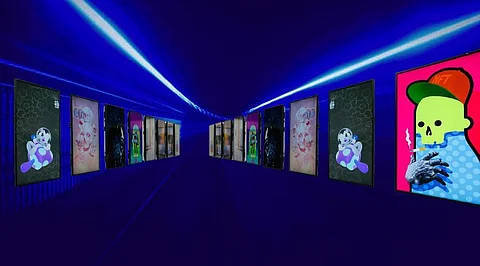

A non-fungible token (NFT) is an unchangeable digital identity that is stored in a blockchain and used to verify ownership and authenticity. It cannot be duplicated, replaced, or divided. NFTs can be bought, sold, and traded because the ownership of each one is tracked in the blockchain and transferable by the owner. Anyone can make NFTs, and they don't necessarily need to know how to code. NFTs frequently make mention of digital items like images, audio, and video. NFTs vary from cryptocurrencies in that they are fungible, while cryptocurrencies are individually identifiable assets. The NFT market expanded significantly between 2020 and 2021with trading of NFTs reaching over $17 billion in 2021, a 21,000% increase over the $82 million in trading in 2020.
Non-fungible tokens (NFTs) have been employed by museums, individuals, and metaverse initiatives as a fresh way to reposition themselves in front of their audience. At a private event on the Decentraland metaverse platform for its art week in August, the family of Frida Kahlo displayed never-before-seen artwork and personal mementos of the artist.
The Royal Institution of Fine Arts in Antwerp, Belgium, made history by becoming the first museum in Europe to tokenize a priceless work of classic art. In order to protect its cultural heritage and make money in the midst of the continuing regional violence, the Kharkiv Art Museum in Ukraine recently established a new NFT collection with Binance. But as everything gets tokenized, concerns surface. Will museums eventually just be enormous NFT galleries with digital counterparts for every piece of artwork
We can better grasp the future of the art world with the help of Hussein Hallak, the founder and CEO of Momentable, a company that works with institutions to assist with NFT integration. Traditional art and museums are absorbing a layer of Web3, while Web3-native digital art finds a home in virtual museums. Hallak contends that the eventual conversion of museums into enormous NFT galleries is "inevitable." "Everything, in our opinion, will be an NFT. There will be an NFT for every product, just like a serial number.
Hallak also claims that all technology needs to become commonplace to get simpler to use. For the time being, he believes that museums should use NFTs primarily for maintaining and verifying the authenticity of the objects in their collections, followed by publicly available digital copies. NFTs are a crucial technological innovation that museums simply cannot ignore if they want to advance, according to Hallak, but they must be integrated into a bigger strategic modernization plan.
When questioned about whether fractional ownership lessens the value of actual, priceless relics kept in museums, Hallak responded that the argument is valid but that the answer is no. Just more people have access to art. He compared it to how a private company's worth would rise after going public. "Making art more accessible through fractionalized ownership or limited digital editions will most certainly promote curiosity, boost the appreciation of the art and artist, and ultimately increase its value," he said. NFTs, in Hallak's opinion, are more of a tool for promoting public art than a transfer of ownership.
The key to Web3 is the ownership that comes with fractionalization. It is one of the distinguishing features that set it apart from earlier internet experiences. If the artwork is still under some form of custodianship in the case of museums and the NFT auction, is it really ownership or is it merely perceived ownership? A recent analysis estimated the market for NFT to be worth about $231 billion by 2030. "A more likely NFT model is funding a public display of artworks and artefacts by developing many digital reproductions," it stated.
As demonstrated with the aforementioned museum in Belgium, NFTs will eventually turn into a way for museums to profit from their holdings and curatorial expertise in a digitally-driven future.
Join our WhatsApp Channel to get the latest news, exclusives and videos on WhatsApp
_____________
Disclaimer: Analytics Insight does not provide financial advice or guidance on cryptocurrencies and stocks. Also note that the cryptocurrencies mentioned/listed on the website could potentially be scams, i.e. designed to induce you to invest financial resources that may be lost forever and not be recoverable once investments are made. This article is provided for informational purposes and does not constitute investment advice. You are responsible for conducting your own research (DYOR) before making any investments. Read more about the financial risks involved here.
